Table of Contents
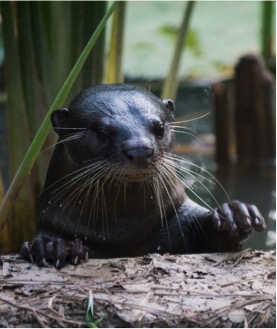
Smooth-coated otter. Photo by Max Khoo, used with permission.
1. Introduction
Owing its name to its short, sleek fur, smooth-coated otters are one of the two otter species found in Singapore (the other being Aonyx cinerea). Though Singapore's landscape has rapidly urbanised over the past 50 years, the highly adaptable smooth-coated otter continues to exist and perhaps even thrive here, as sightings of it have increased over the last decade [1] [2]. Previously, smooth-coated otters were mostly sighted in the mangroves, mudflats and coastal areas such as Sungei Buloh Wetland Reserve, Pasir Ris, Pulau Ubin, and Changi [3]. Though, more recently, these delightful otters have begun to make use of our urban waterways, and can commonly be spotted in parks and reservoirs as well. Contrary to what some might believe, none of the wild otters in Singapore were zoo releases. Rather, they are believed to have come from Malaysia, driven across the straits by the coastal development works in Johor.
Etymology
The original scientific name of the smooth-coated otter, or a synonym of Lutrogale perspicillata, is Lutra perspicillata. Lutra originates from udréh, a Proto-Indo-European (reconstructed prehistoric language of Eurasia) word relating to the idea of "water" [4]. While the source of the initial-l is unclear and unspecified, some have guessed at its connection to lupus (Latin for "wolf"), portraying otters as "water wolves", or lūdō (Latin for "play"), suggesting at the otters' playfulness [4]. Perspicillata means "conspicuous" in Latin. The choice of terms, given by Geoffroy Saint-Hilaire, were not explained [5].2. Description
They are one of the larger otter species, growing up to 1.2m from the head to the tip of the tail and usually weighing around 7 to 11kg [6]. The colour varies from dark to reddish brown, with the belly slightly paler and the throat, side of neck, cheeks, and upper lip whitish or gray [7]. Its eyes and ears are small while its limbs are short and strong [7]. The fur of the smooth-coated otter is very short, growing up to only 12mm in length, thus giving it the smooth and sleek look to which it owes its common name [6].
Diagnosis
Like most other otters, the smooth-coated otter has webbed feet and adept paws [8].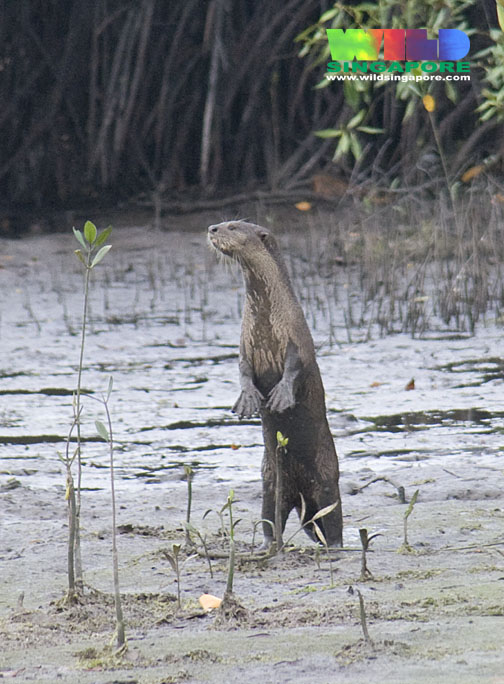
However, there are certain characteristics of the smooth-coated otter that sets it apart from all other otters. Its bigger and rounder head and flat tail are some of the clear traits differentiating smooth-coated otters from common otters (Lutra lutra) [7].
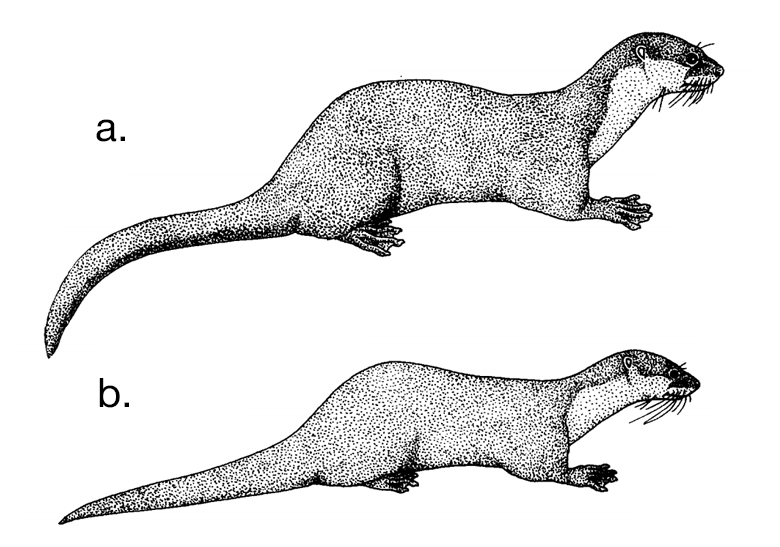
The hairless nose of the smooth-coated otter also almost immediately sets it apart from the hairy-nosed otter (Lutra sumatrana) [7]. It also differs from the Asian small-clawed otter (Aoyx cinerea) by having well developed sharp claws on its front feet [6] [7].
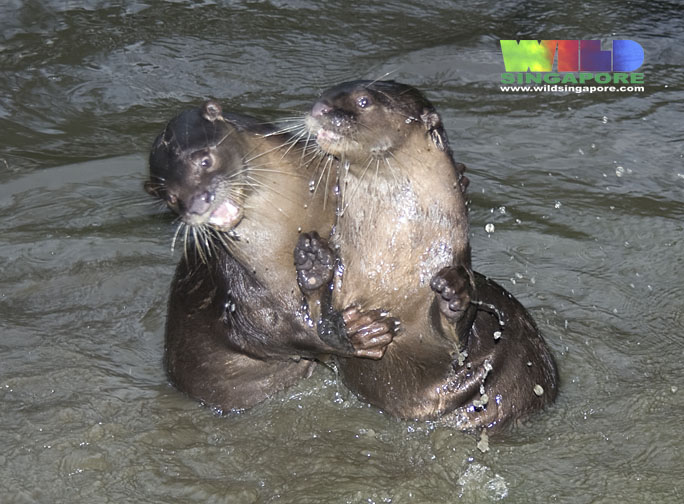
Two smooth-coated otters playing, where the sharp claws on the right front foot of the otter on the left is can clearly be seen. At the same time, throat, side of neck, cheeks, and upper lip are visibly paler than the rest of the body as well.Photo by Ria Tan, used with permission.
3. Biology
Diet
The bulk of the smooth-coated otter's diet (>75%) is made up of fish such as tilapia and catfish [10]. They sometimes hunt in groups of up to 11, herding the fishes together for easy capture [8] [10]. Though, being highly adaptable, these otters are able to rely on other food sources such as frogs, insects, crabs, other smaller mammals such as rats, and even snakes [6] [11].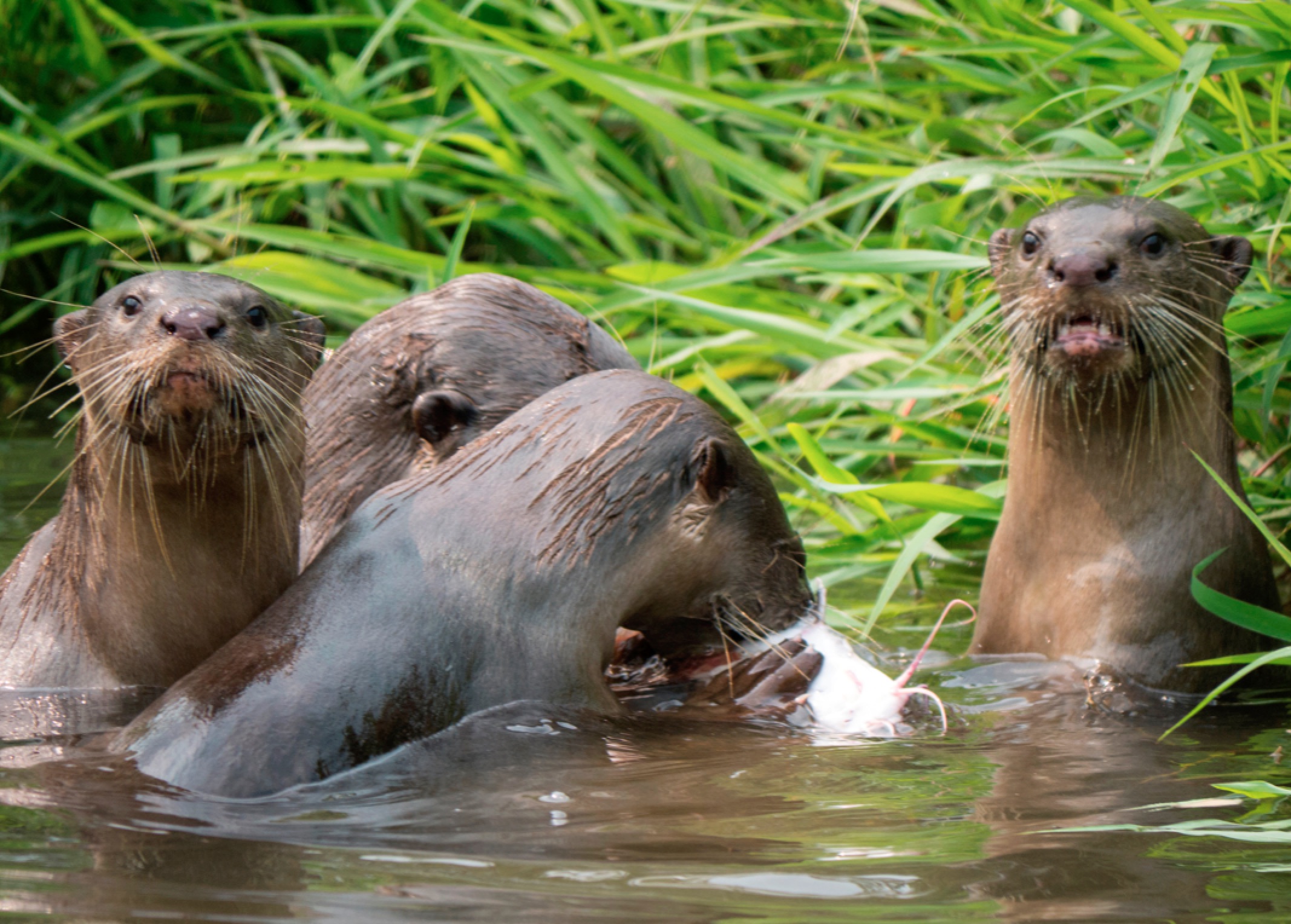
Even though wild smooth-coated otters are naturally carnivores, captive otters such as those in zoos will eat nuts and raisins if given those as well [12].
Activity Pattern
Activity pattern of the smooth-coated otter varies depending on the season. In the summer season, the otters tend to adopt a bimodal activity pattern which means that there are two active periods in a day - late afternoon and past midnight [13]. In winter, it appears that the otters prefer a trimodal activity pattern, with peak activity periods occurring in the early morning, late afternoon, and before midnight [13]. As many factors influence the smooth-coated otter's activity pattern, there is no clear reason for the variation between the seasons [13].As Singapore experiences summer all year long, the activity pattern of the local otters have been found to be bimodal and diurnal, with peak activity occurring in the morning and evening [14]. Most of the smooth-coated otter's time is spent travelling and foraging, while other activities throughout the day include grooming, social activities, digging, and sprainting [14].
Story of the smooth-coated otter family at Bishan-AMK Park, Singapore. Video credits: Fast Snail.
Social Structure
Unlike other otter species which might live in big groups of up to 100, smooth-coated otters form small family groups consisting of the mating pair and their pups, if present [8].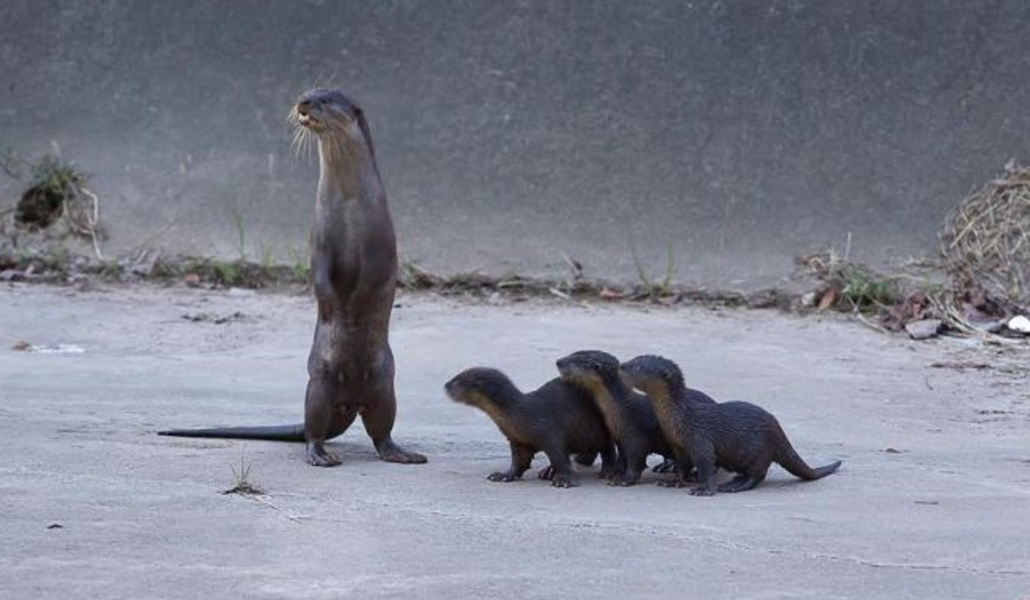
Reproduction
Smooth-coated otters are monogamous. Though the male otters are bigger, it is usually the females who are more dominant in the relationship [12] [15]. Smooth-coated otters usually breed only when they are 2 or 3 years old [16]. There are no specific mating seasons for smooth-coated otters and they can potentially mate all year round [12].The gestation period for smooth-coated otters is approximately 63 days [12]. During this period and right after giving birth, the female is usually very aggressive and will fiercely protect her pups [12]. Thus, though baby otters look extremely adorable, be careful not to approach suddenly or get too close to the otters or you risk facing the wrath of the mother otter.
Pup litters usually range from 2-5 and both parents will raise the pups together in a holt usually near the water [15]. Pups, usually born blind and helpless, will stay with their parents for up to a year, during which their parents will teach them to swim and forage, among other things [8] [15]. The average smooth-coated otter usually lives up to 10 years of age [6].
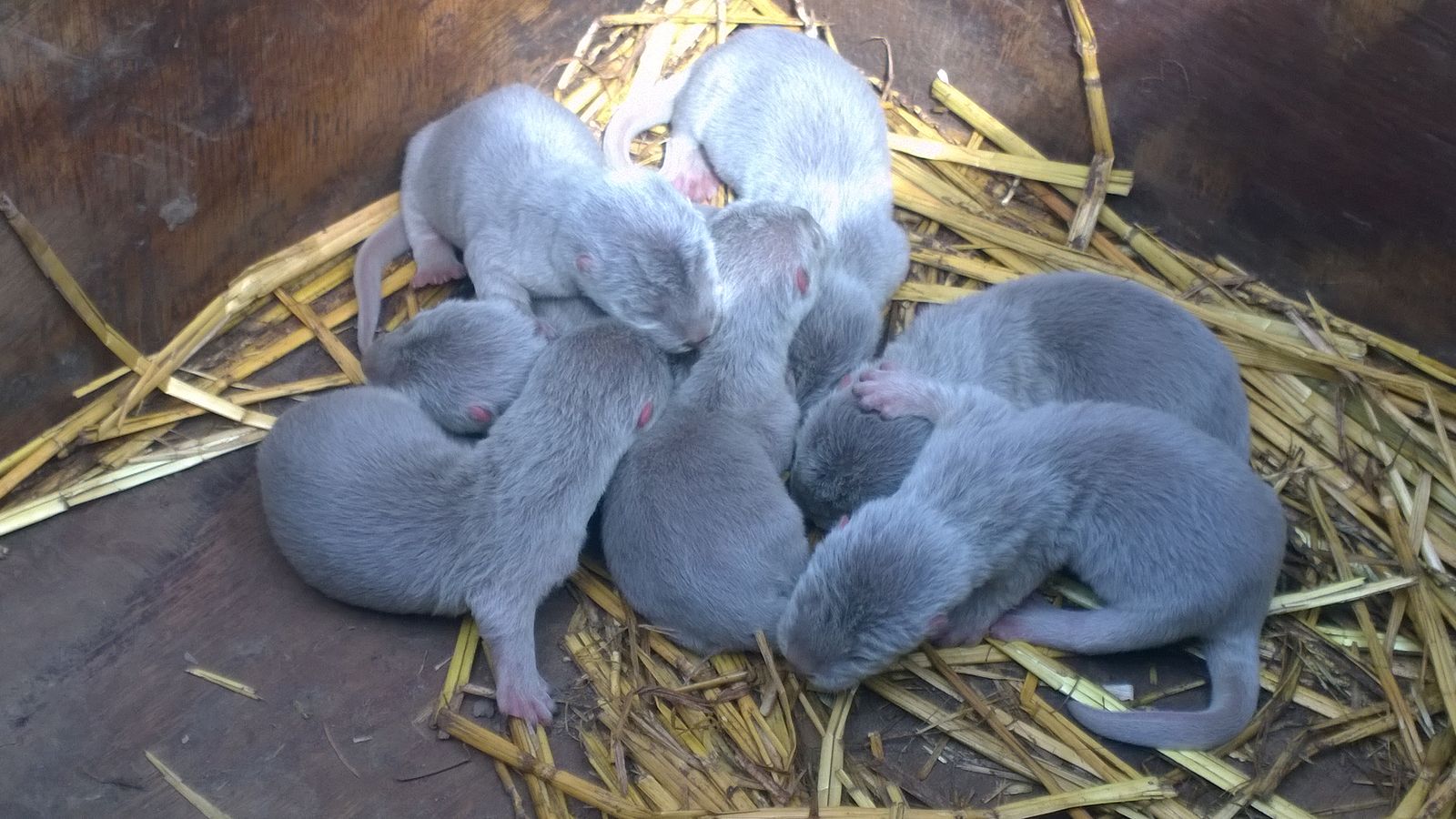
4. Ecology
Global Distribution
Widely distributed in south and southeast Asia, the smooth-coated otter can be found in a continuous range stretching from Indonesia to southern China, and then westwards to India and Pakistan [16]. There is also an isolated population of smooth-coated otters in Iraq, suggesting that its geographic range might have once been wider than it is today [17]. It is unknown exactly how many individuals are left in the wild.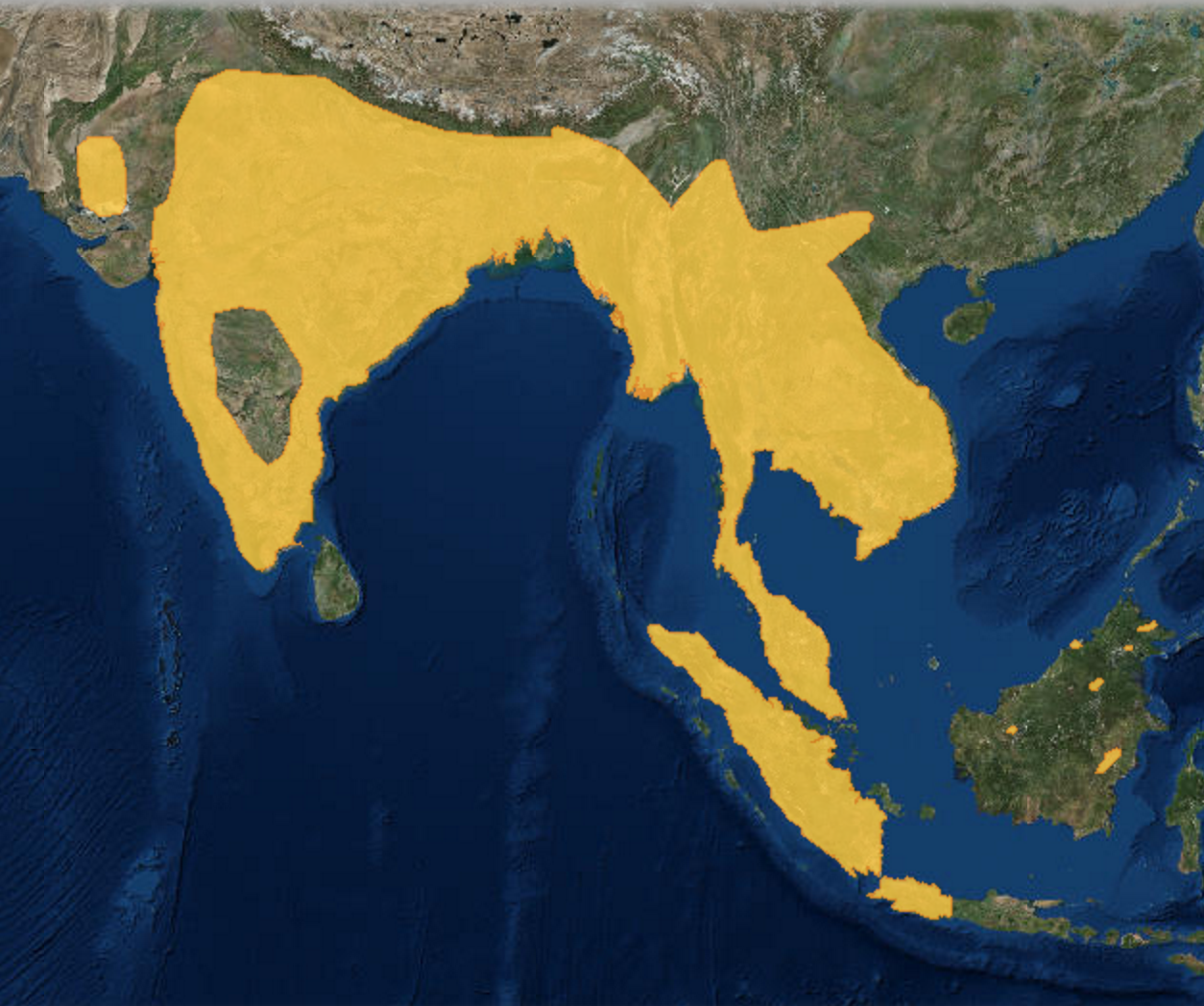
Distribution in Singapore
The first sighting of a smooth-coated otter in Singapore was in 1938, a male at Lazarus Island [3]. After which, there was a long period of absence during which it was thought to have become extinct in Singapore. It was suggested that the local population of smooth-coated otters were not residents as they could easily travel between Singapore and Johor [18]. However, a second recorded sighting took place more than half a century later, at Sungei Buloh Wetland Reserve in 1990 [3]. Ever since, the sightings have been increasing in both number and range, with smooth-coated otters not just spotted at Sungei Buloh, but also places like Pasir Ris, Changi and Tanah Merah [3] [19]. Recently, two smooth-coated otter families have even made Bishan-AMK Park and Marina Reservoir their home [14] [19] [20]. Watch the video below to follow the story of the otter family at the Bishan-AMK Park.Story of the family of otters at Bishan-AMK Park, Singapore. Video credits: Fast Snail.
Habitat
Smooth-coated otters are semi-aquatic and require both terrestrial and aquatic habitats to survive [10]. Having a water body is essential for feeding and swimming, which otters enjoy immensely [11]. On the other hand, their holt (or den) and territorial spraint sites are on land, usually near or beside the water body. As such, smooth-coated otters can commonly be found where water bodies meet land, such as mangroves, mudflats and coastal areas [3]. While they are able to swim in the sea, smooth-coated otters primarily require fresh water [7].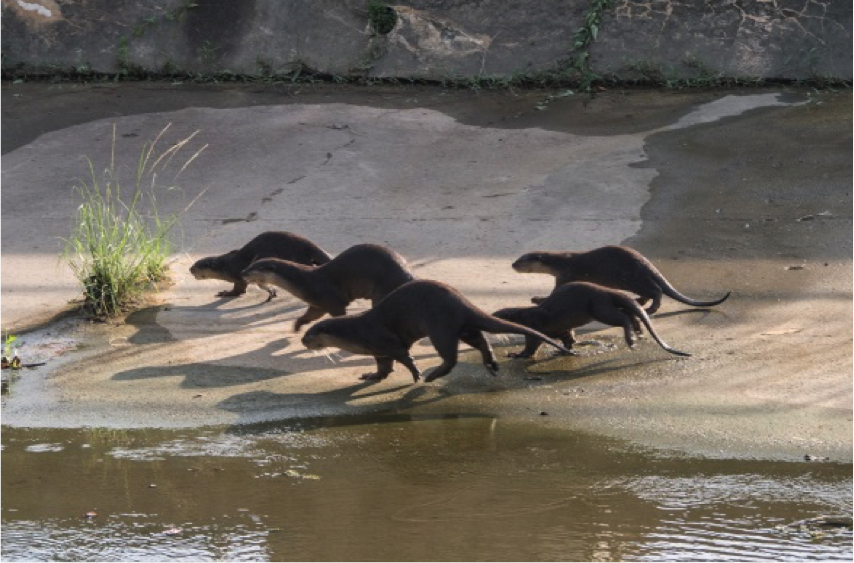
5. Relationship with Humans
Human-Otter Conflict
Global ThreatsWith a general decreasing population size, smooth-coated otters have been listed as vulnerable (VU) on IUCN's Red List. This is largely due to anthropogenic reasons. With an increase in the number and scale of hydroelectric projects and a rise in wetland reclamation, habitat destruction is a major reason for the smooth-coated otter's decline [6] [16]. In addition, pollution of waterways by pesticides and agricultural run-off leading to a decrease in prey (fishes) for the otters has also been identified as a cause of its decline [6] [16].
With their diet largely comprising of fish, it comes as no surprise that smooth-coated otters also experience serious and widespread conflict with aquaculturists and fishermen [6] [16]. They are often viewed as pests or competitors and thus killed [6]. In India, Nepal and Bangladesh, these furry creatures are even deliberately trapped and killed for their fur [6].
Local Threats
In urban Singapore, one of the threats that the smooth-coated otters face is onshore traffic [2]. There were two reports of otters hit by traffic in 2011, one in Harbour Drive near West Coast Park, and another near Bedok Reservoir [2]. More recently, a video that went viral showed a man unethically trying to bait the otters with a fishing hook at the Kallang River [21], causing many to speak up against animal cruelty. It was probably done out of curiosity towards these fairly new creatures to Singapore and resulted in one otter pup being injured. However, the man has since voluntarily identified himself to the police and the otter pup has fully recovered as well [21].
Additionally, otters are highly adaptable and inquisitive by nature. As such, otters in urban areas such as Singapore have often been sighted venturing into human-populated areas [22] [23] and their presence is not always welcomed. In mid-2015, the smooth-coated otters made the headlines in Singapore for feasting on ornamental koi worth over SGD$80,000 [24] [25].
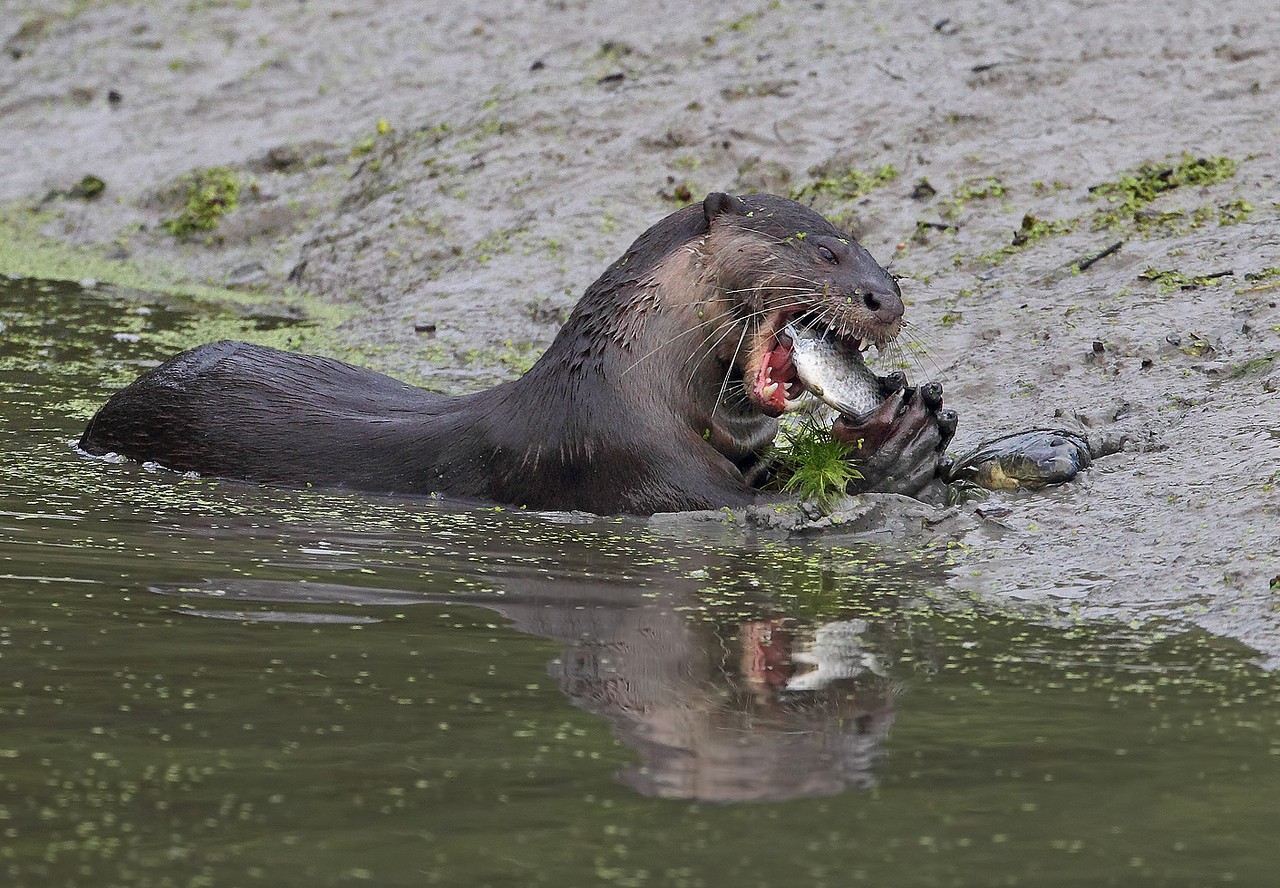
One other threat that the smooth-coated otters are facing not in Singapore, but in the local region, is coastal development in Johor. As the otter's habitat is destroyed, they are forced across the straits, which is also the suggested reason for the increased sightings of otters in Singapore (as mentioned in the introduction) [14].
Living in Harmony
While the smooth-coated otters of Singapore have become a nuisance in some places, they have also won over the hearts of many with their amiable and endearing antics [26] [27] [28].This morning, I found the "TRUE" owner of Bishan-AMK otter family =)
Posted by Fast Snail on Tuesday, October 6, 2015
The playful smooth-coated otters at Bishan-AMK Park interacting with an elderly man trying to take photos of them. Video credits: Fast Snail.
To ensure that people continue to live in harmony with the smooth-coated otters, the National Parks Board (NParks) has issued the following advisory [29]. Should one ever encounter the otters:
- Do not touch, chase or corner the otters, and observe them from a distance; going too close may frighten them.- Stay quiet and avoid flash photography; noise and light may scare or provoke the otters.- Do not feed the otters; they have plenty of fish from the river to feast on and their natural eating habits keep the ecosystem healthy.- Keep your dog on a tight leash; your dog might chase and frighten the otters.- Additionally, do not litter or leave sharp objects in the water; keep the otters' habitats clean and healthy.
Should members of the public spot any injured otters, they can call the ACRES Wildlife Rescue Hotline, 9783-7782.
6. Taxonomy
Taxonavigation
The classification of Lutrogale perspicillata is as follows [16]:Animalia
Chordata
Mammalia
Carnivora
Mustelidae
Lutrogale
L. perspicillata
Each taxon is a subset of the one above it. The use of ranks has been discarded as they do not contain any meaningful taxonomic information.
Synonyms
Lutra perspicillata (Geoffroy, 1826)Lutra simung (Lesson, 1827)
Lutra tarayensis (Hodgson, 1839)
Lutra ellioti (Anderson, 1878)
Lutrogale perspicillata (Pocock, 1940)
Type Specimen
The original type specimen of L. perspicillata first described and documented by Geoffroy in 1826 was not preserved.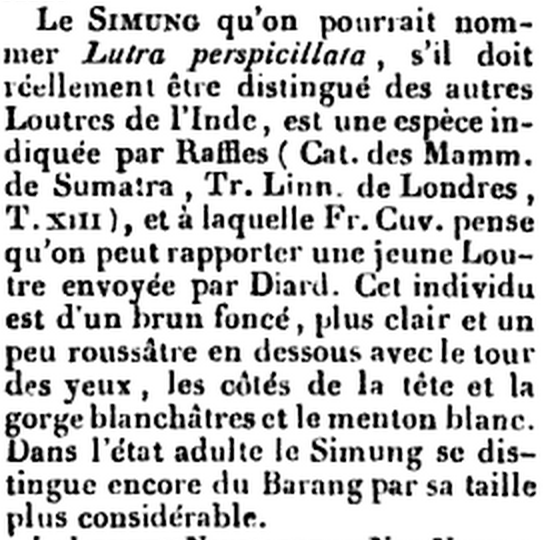
However, there exists three subspecies of L. perspicillata and the holotype of one of them, L. p. maxwelli, was found in Iraq and is kept under the Natural History Museum (London) Collection Specimens [30]. The existing holotype of L. p. maxwelli is a juvenile male.
Subspecies
As mentioned above, there exists three subspecies of L. perspicillata - L. p. perspicillata (Geoffroy, 1826), L. p. sindica (Pocock, 1949), and L. p. maxwelli (Hayman, 1957) . They are mainly distinguished by their colour [31].L. p. perspicillata has a dark chestnut brown coat, with a whitish chin and paler belly and feet. L. p. maxwelli is very similar to L. p. perspicillata in that it also has a coat of dark brown fur. However, the chin is iron-grey rather than white, and the belly is only slightly paler than the rest of the coat. L. p. sindica is a much paler animal compared to L. p. perspicillata and L. p. maxwelli, varying from tawny to greyish. In addition, it is also the smaller in size than the other two subspecies. No pictures have been provided as there is a lack of reliable sources that have appropriately distinguished between the subspecies.
Phylogeny
Based on behaviour, vocalizations and morphology, especially that of the skull, it was initially thought that the closest relative of L. perspicillata would be Pteronura brasiliensis (giant otter) [32] [33]. Because P. brasiliensis entered North America from Asia in the Pliocene, it was thought that the common ancestor between P. brasiliensis and L. perspicillata gave rise to L. perspicillata some time in the Mid-Miocene before evolving into P. brasiliensis after entering North America [32] [33].However, later on, a molecular analysis for L. perspicillata was conducted and the results revealed that its closest relative was Aonyx cinerea (Asian small-clawed otter) rather than P. brasiliensis [34].

7. Useful Links
IUCN Otter Specialist Group - leading global otter conservation
Otter Watch - consolidation of otter sightings in Singapore
Fast Snail - watch videos of the playful resident otters in Singapore
8. References
[1] Theng, M. & N. Sivasothi, 2011. Status, distribution and diet of the smooth-coated otter Lutrogale perspicillata (Geoffroy, 1826) in Singapore. Unpublished UROPS, National University of Singapore.
[2] "More sightings of wild otters in Singapore", by David Ee. The Straits Times, 22 April 2013. Hosted on Wild Singapore. URL: http://wildsingaporenews.blogspot.sg/2013/04/more-sightings-of-wild-otters-in.html#.VkMnGa4rK34 (accessed on 11 November 2015).
[3] "Smooth-coated otter", by Ria Tan, 2009. Wild Singapore. URL: http://www.wildsingapore.com/wildfacts/vertebrates/mammals/perspicillata.htm (accessed on 4 November 2015).
[4] Lewis, C. T. & C., Short, 1879. A Latin Dictionary. Oxford: Clarendon Press.
[5] Geoffroy, S. H. 1826. Dictionnaire classique d'Histoire Naturelle. 9: 515–520.
[6] "Lutrogale perspicillata (Geoffroy Saint-Hilaire, 1826), the Smooth-coated otter", by IUCN Otter Specialist Group, 2015. URL: http://www.otterspecialistgroup.org/Species/Lutrogale_perspicillata.html (accessed on 4 November 2015).
[7] Hwang, Y. T. & S., Larivière, 2005. Mammalian Species: Lutrogale perspicillata. American Society of Mammalogists, 786: 1-4.
[8] "Otters", CITES Identification Sheet, n.d. URL: https://portals.iucn.org/library/efiles/html/Otter/Appendix%201f68.html (accessed on 4 November 2015).
[9] Sivasothi, N. & B. H. M., Nor, 1994. A review of otters (Carnivora: Mustelidae: Lutrinae) in Malaysia and Singapore. 85: Hydrobiologia, 285: 151-170.
[10] Kruuk, H., 1995. Wild otters - predation and population. Oxford: Oxford University Press. 290 pp
[11] .Anoop, K. R. & S. A., Hussain, 2005. Food and feeding habits of smooth-coated otters (Lutra perspicillata) and their significance to the fish population of Kerala, India. The Zoological of London, 266: 15-23.
[12] "Minimum husbandry guidelines for smooth-coated otters in captivity", by IUCN/SSC Otter Specialist Group Otters in Captivity Task Force. IUCN Otter Specialist Group, 2008. URL: http://www.otterspecialistgroup.org/Library/TaskForces/OCT/Husbandry_Guidelines_for_Keeping_Smooth-Coated_Otters_in_Captivity_1st_Edition.pdf (accessed on 4 November 2015).
[13] Hussain, S. A., 1995. Seasonal movement, home range, and habitat use by smooth-coated otters in National Chambal Sanctuary, India. Habitat, 11: 45-55.
[14] Khoo, M., 2015. Home range and diurnal activity pattern of two family groups of Lutrogale perspicillata (Geoffroy, 1826) along the Kallang River. Unpublished UROPS, National University of Singapore.
[15] Mason, C. F. & S. M., MacDonald, 1986. Otters ecology and conservation. New York, New York: Cambridge University Press. 236pp.
[16] de Silva, P., W. A., Khan, B., Kanchanasaka, I. Reza Lubis, M. M., Feeroz & O. F., Al-Sheikhly, 2015. Lutrogale perspicillata. The IUCN Red List of Threatened Species 2015.
[17] Kruuk, H., 2006. Otters: Ecology, Behaviour and Conservation. Oxford: Oxford University Press. 280 pp.
[18] Davidson, G. W. H., P. K. L., Ng & H. C., Ho, 2008. The Singapore Red Data Book: Threatened plants and animals of Singapore. Nature Society (Singapore). 285 pp.
[19] "Otters in Singapore: About", by Meryl Theng, 2014. URL: http://blog.nus.edu.sg/sgotters/about/ (accessed on 10 November 2015).
[20] "'SG50 Triplets': Baby Otters spotted at Bishan-Ang Mo Kio Park", Channel News Asia, 20 April 2015. URL: http://www.channelnewsasia.com/news/singapore/sg50-triplets-baby-otters/1794600.html (accessed on 10 November 2015).
[21] Wong, P. T., 2015. "Alleged otter baiting: Authorities looking into possible case of animal cruelty", by Wong Pei Ting. Channel News Asia, 25 October 2015. URL: http://www.channelnewsasia.com/news/singapore/alleged-otter-baiting/2216036.html (accessed on 11 November 2015).
[22] "An otter delight at Gardens by the Bay", by David Ee. The Straits Times, 4 March 2014. URL: http://www.straitstimes.com/singapore/an-otter-delight-at-gardens-by-the-bay (accessed on 11 November 2015).
[23] "Otter family of 5 enrols into Saint Andrew's Junior College", by Belmont Lay. Mothership, 21 October 2015. URL: http://mothership.sg/2015/10/otter-family-of-5-enrols-into-st-andrews-junior-college/ (accessed on 11 November 2015).
[24] "Did otters really eat koi worth $80,000?", by Samantha Boh. The Straits Times, 9 July 2015. URL: http://www.straitstimes.com/singapore/did-otters-eat-koi-worth-80000 (accessed on 11 November 2015).
[25] Lim, X. Z., 2015. "Otters blamed for 'gory' scene on Sentosa", by Lim Xuan Zhen. My Paper, 1 July 2015. Hosted on AsiaOne: http://news.asiaone.com/news/singapore/otters-blamed-gory-scene-sentosa (accessed on 11 November 2015).
[26] "Curious Bishan-Ang Mo Kio Park triplet baby otters totally enamoured with terrapin, can't seem to leave it alone", by Belmont Lay. Mothership, 15 June 2015. URL: http://mothership.sg/2015/06/curious-bishan-ang-mo-kio-park-triplet-baby-otters-totally-enamoured-with-terrapin-cant-seem-to-leave-it-alone/ (accessed on 11 November 2015).
[27] "Video shows Bishan-Ang Mo Kio Park otters successfully integrating, mingling with Singaporeans", by Belmont Lay. Mothership, 9 October 2015. URL: http:mothership.sg/2015/10/video-shows-bishan-ang-mo-kio-park-otters-successfully-integrating-mingling-with-sporeans/ (accessed on 11 November 2015).
[28] "Mommy otter fetches fresh fish from Kallang River to feed her baby otters", by Belmont Lay. Mothership, 4 August 2015. URL: http://mothership.sg/2015/08/mommy-otter-fetches-fresh-fish-from-kallang-river-to-feed-her-baby-otters/ (accessed on 11 November 2015).
[29] "Let's make Singapore our Garden", by National Parks Board. Facebook post, 19 April 2015. URL: https://www.facebook.com/nparksbuzz/posts/888035821235895 (accessed on 11 November 2015).
[30] "Specimen of Lutrogale perspicillata (Geoffroy Saint-Hilaire, 1826)". Global Biodiversity Information Facility. URL: http://www.gbif.org/occurrence/1057425429 (accessed on 11 November 2015)
[31] "Classification of the smooth-coated otter", by Wright L. C.. Otter Joy, 11 April 2013. URL: http://www.otterjoy.com/otterinfo/lutrogale/perspicillata/perspicillata_classification.html (accessed on 11 November 2015).
[32] Duplaix, N., 1980. Observations of the behaviour and ecology of the Giant River Otter Pteronura brasiliensis in Suriname. Rev Ecol (Terre Vie). 34: 495-620
[33] Willemsen, G. F., 1992. A revision of the Pliocene and Quaternary Lutrinae from Europe. Scripta Geologica. 101: 1-115.
[34] Koepfli, K. P., B., Kanchanasaka, H., Sasaki, H., Jacques, K. D. Y., Louie, Toanvong Hoai, N. X., Dang, E., Geffen, A., Gutleb, S-Y., Han, T. M., Heggberget, L., Lafontaine, H., Lee, R., Melisch, J., Ruiz-Olmo, M., Santos-Reis, V. E., Sidorovich, M., Stubbe & R. K., Wayne, 2008. Establishing the foundation for an applied molecular taxonomy of otters in Southeast Asia. Conserv. Genet.